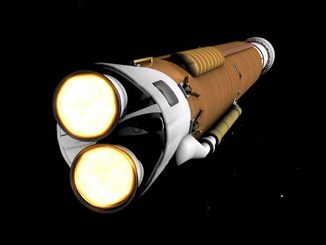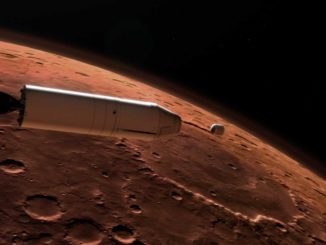EDITOR’S NOTE: Updated Nov. 8 with confirmation of Parker Solar Probe’s health after perihelion.

Less than three months after its fiery departure from Cape Canaveral, NASA’s Parker Solar Probe flew within 15 million miles (24 million kilometers) of the sun Monday for the $1.5 billion mission’s first close-up solar encounter.
Flying in an autonomous mode out of contact with ground controllers, the solar probe was on a trajectory that reached its closest point to the sun at 10:28 p.m. EST Monday (0328 GMT Tuesday), according to NASA.
Parker Solar Probe is circling the sun in an elliptical loop that takes the spacecraft from perihelion — the closest point to the sun which it passed Monday — to a distant point between the orbits of Venus and Earth. The spacecraft’s perihelion Monday reached a position less than half the distance from the sun as Mercury.
“You’re going into an environment that’s completely unforgiving,” said Andy Driesman, Parker Solar Probe’s project manager at the Johns Hopkins University Applied Physics Laboratory, which built and operates the spacecraft. “The temperatures that we are seeing on the spacecraft have not been seen by any other spacecraft ever before. The first perihelion we’re going into, we have very minimal contact. All we can get is a tone.”
Ground controllers at APL received a good status tone from Parker at 4:46 p.m. EST Wednesday (2146 GMT), confirming the probe survived the first of at least two dozen journeys close to the sun.
“Parker Solar Probe was designed to take care of itself and its precious payload during this close approach, with no control from us on Earth — and now we know it succeeded,” said Thomas Zurbuchen, associate administrator of NASA’s Science Mission Directorate at the agency headquarters in Washington. “Parker is the culmination of six decades of scientific progress. Now, we have realized humanity’s first close visit to our star, which will have implications not just here on Earth, but for a deeper understanding of our universe.”
The spacecraft launched Aug. 12 from Cape Canaveral aboard a United Launch Alliance Delta 4-Heavy rocket, which propelled Parker Solar Probe on a high-speed departure from Earth on the way to Venus. The solar probe flew by Venus on Oct. 3 at a distance of about 1,500 miles (2,400 kilometers), using the planet’s gravity like a brake to slow its velocity enough for the sun to pull the spacecraft closer.
The probe set a record Oct. 29 for the closest approach by a human-made object to the sun, besting a mark set in April 1976 by the German-American Helios 2 spacecraft at a distance of 26.55 million miles (42.7 million kilometers). On the same day, Parker Solar Probe became the fastest spacecraft relative to the sun, exceeding a heliocentric velocity of 153,454 mph (42.6 miles per second; 68.6 kilometers per second).

The spacecraft started its first solar encounter phase Oct. 31, and reached the closest point to the sun in its current orbit late Monday, reaching a top speed relative to the sun of 213,200 mph (59.2 miles per second; 95.3 kilometers per second).
Parker Solar Probe was expected to fly through a region of tenuous material in the sun’s outer atmosphere, where temperatures reach 3.6 million degrees Fahrenheit (2 million degrees Celsius), according to a statement released by APL.
The spacecraft is armored for the extreme temperatures, carrying a 4.5-inch thick (11.4-centimeter) carbon composite heat shield covered in a white ceramic coating. The thermal barrier measures around 8 feet (nearly 2.5 meters wide) on the sun-facing side of the probe, keeping most of the craft’s components — except a few of its sensors and solar arrays — at a little above room temperature.
The outside of the heat shield was expected to reach a temperature of around 820 degrees Fahrenheit (437 degrees Celsius) during Monday’s closest approach to the sun, significantly lower than the temperature of the surrounding environment. The low-density particles in Parker Solar Probe’s orbit do not transfer much of their heat to the spacecraft, allowing it to survive the conditions similar to the way you can put your hand in a kitchen oven — as long as you don’t touch any surfaces.
“We keep the thermal shield between the spacecraft body and the sun,” said Betsy Congdon, lead thermal engineer on Parker Solar Probe at APL. “We have designed the spacecraft to be able to do the right thing, no matter what it sees.”
Scientists programmed Parker Solar Probe’s four instrument suites to directly measure the properties of the material in the solar atmosphere, collecting data closer to the sun than ever before. Parker Solar Probe’s objectives include studying the origin of the solar wind, a supersonic flow of particles streaming away from the sun in every direction, which drives space weather and influences the entire solar system.
Named for Eugene Parker, who correctly predicted the existence of the solar wind in 1958, Parker Solar Probe will also investigate why the sun’s atmosphere, or corona, is many times hotter than the sun’s surface.
Controllers are unable to fully contact Parker Solar Probe for several days around perihelion due to the interference from solar radio emissions, officials said. Only basic status tones will be transmitted from the spacecraft back to Earth to confirm its health.
Parker Solar Probe carries autonomous control software to ensure temperature-sensitive components don’t get too hot, using inputs from temperature sensors to gauge where the probe should be pointed, and to keep key parts of the spacecraft in the heat shield’s shadow. The probe’s solar panels can also be pivoted or turned to stay within thermal limits, all without the intervention of ground controllers.
At the time of Monday’s perihelion, Parker Solar Probe was located around 98 million miles (158 million kilometers) from Earth. At that distance, it takes more than 17 minutes for radio signals to make the round-trip journey from the spacecraft to Earth and back.
The encounter phase ends Nov. 11, and the first science data from Parker Solar Probe’s first perihelion will be downlinked to Earth beginning in early December.
Monday’s solar encounter was the first of 24 planned during the probe’s mission.
Six more Venus flybys will spiral Parker Solar Probe ever-closer to the sun, redirecting the craft’s trajectory toward its closest encounter with the sun at a distance of 3.83 million miles (6.16 million kilometers) in 2024, roughly 4 percent the distance of the sun from Earth.
Email the author.
Follow Stephen Clark on Twitter: @StephenClark1.



